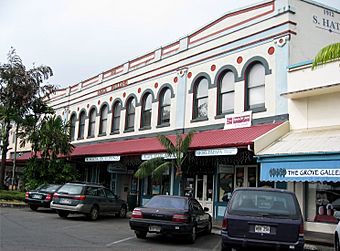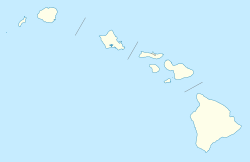S. Hata Building facts for kids
Quick facts for kids
Hata Sadanosuke
|
|
|---|---|
| Born | 1868 |
| Died | |
| Nationality | Japanese American |
| Occupation | Businessman |
| Spouse(s) | Shindo Masae |
| Children | 1 son, 4 daughters (Tamotsu +?) |
|
S. Hata Building
|
|

Built for Hata Sadanosuke
|
|
| Location | 308 Kamehameha Avenue, Hilo, Hawaii |
|---|---|
| Built | 1912 |
| Architect | William C. Furer |
| Architectural style | Early Commercial |
| NRHP reference No. | 91001087 |
| Added to NRHP | August 27, 1991 |
|
Hata Yoichi
|
|
|---|---|
| Born | 1884 |
| Died | |
| Nationality | Japanese American |
| Occupation | Businessman |
| Spouse(s) | Hirata Naeko |
| Children | Yukiko, Minoru, Susumu, Akira, Yoshimi, Frank J +? |
The S. Hata Building is a very old and important building in Hilo, Hawaii. It was built in 1912 by a Japanese businessman named Hata Sadanosuke. Today, the building has cool shops, offices, and a restaurant. It's a special part of Hilo's history.
Contents
The Hata Family Story
Sadanosuke Hata's Journey
Hata Sadanosuke was born in Hiroshima, Japan in 1868. He moved to Honolulu, Hawaii in 1891. In 1893, he worked for a company called Odo Shoten. "Shoten" means "store" in Japanese. His job was to take orders from big sugarcane farms. These farms were on the Hāmākua Coast. Many Japanese immigrant workers lived there.
This job gave Sadanosuke a great idea. He decided to start his own business. On January 3, 1896, he opened S. Hata Shoten, Limited, in Hilo. He sold Japanese silks, traditional kimonos, and souvenirs. At first, business was slow. So, he even used his horse and carriage as a taxi!
Growing the Business
In 1898, Hawaii became part of the United States. The sugar farms grew a lot, and so did Sadanosuke's business. He moved his store to a bigger building. It was at the corner of Mamo and Keawe streets. His business also grew to other cities. He opened branches in Honolulu, and in Japan: Hiroshima, Osaka, Japan, Kyoto, Japan, and Yokohama, Japan.
Yoichi Hata Joins In
Sadanosuke's younger brother, Hata Yoichi, was born in 1884. He also came to Hilo. Yoichi worked as a bookkeeper at S. Hata Shoten. By 1912, the business was doing so well it needed even more space. The old building became a place to sell food in large amounts. Yoichi Hata managed this part of the business.
Sadanosuke then planned a brand new building. It would cost $25,000. He chose a spot on Front Street, which is now Kamehameha Avenue. This land was near the railroad tracks. The U.S. government sold him the land. But there was a rule: he had to build a concrete building within one year.
The S. Hata Building
Building a Strong Structure
When the S. Hata Building was constructed, most buildings in Hawaii were made of wood. This new building was different. It was made of strong, reinforced concrete. It measured about 109 feet (33 m) long and 60 feet (18 m) wide. Building such a large concrete structure showed how successful the Japanese community was becoming. Other strong buildings from that time include the Hilo Masonic Lodge and the Hilo Federal Building.
The first floor of the S. Hata Building had several storefronts. A wooden staircase led up to the second floor. This floor had offices and 14 arched windows. In 1913, Sadanosuke also opened the Hilo Sake Brewing Company. Later, in 1919, two wooden buildings were added to the back. One was for business, and the other was a home.
Surviving Tough Times
During the Second World War, many Japanese American families faced difficulties. The Hata family was part of the Japanese American internment. In September 1942, the U.S. government took the Hata Building. It was later sold at an auction. Sadanosuke's second daughter, Kagawa Kasujiro, bought the building back.
Because the building was so well-built, it survived a huge tsunami in 1946. This tsunami was caused by an earthquake and destroyed much of Hilo. The train tracks near the building were also ruined. So, the S. Hata Building ended up being on the main commercial street closest to the ocean. The old railroad path became part of the new Hawaii Belt Road.
Restoration and New Life
The building originally had a full basement. But after another big tsunami in 1960, the basement was filled in. Over time, the building started to wear down. By 1990, it was almost going to be torn down.
Then, a person named David Levenson bought the building from the Hata family. He worked to fix up the inside and restore the outside. He replaced a metal awning but kept the old iron decorations. The building is located at 308 Kamehameha Avenue. Today, many local businesses rent space there.
The Hilo Farmers Market started nearby in 1988. It happens every Wednesday and Saturday. The S. Hata Building was recognized as a state historic site in 1989. It was also added to the National Register of Historic Places listings on the island of Hawaii in 1991. In 1999, the Hata family started a charity. It helps the Japanese Cultural Center of Hawaii in Honolulu. In 2003, the Takeyama family bought the building.
Yoichi Hata's Legacy
Yoichi Hata married Naeko Hirata in 1905. They had many children. Yoichi became a director at the Peoples Bank of Hilo in 1916. In 1922, his company, Y. Hata, became its own separate business. It is still run by a Hata family member today!
Y. Hata opened branches in Osaka, Japan, in 1936 and Honolulu in 1937. After the 1960 tsunami, their old wholesale building was no longer used. Offices moved to new areas in Hilo and Honolulu. Today, Y. Hata delivers food to stores all over Hawaii. They also provide supplies and services to restaurants and even the U.S. military in Hawaii. Yoichi's son Minoru was the CEO for many years. Then, his son Frank was chairman until 2008. Frank's son, Russell Hata, took over in May 2008.
Mokupāpapa Discovery Center
The Mokupāpapa Discovery Center is an exciting place to learn. It used to be in the S. Hata Building. Now, it has moved down the street to the historic Koehnen Building at 76 Kamehameha Avenue in Hilo.
The center teaches visitors about the Papahānaumokuākea Marine National Monument. This monument protects the Leeward Islands and the waters around them. "Mokupāpapa" is a Hawaiian word. It means "flat/low reef island." This name was used in old Hawaiian chants. It might have referred to the area now called French Frigate Shoals. Or it could have meant the northwestern islands in general. These islands stretch far northwest of the main Hawaiian Islands. The discovery center is on Hawaii Island, which is the youngest island in the chain.
Inside the center, you can see a large salt-water aquarium. It holds about 3,500 US gallons (13,000 L) of water. The aquarium shows fish found on Hawaiian reefs. One whole wall has a huge mural. It was painted by local artist Layne Luna. The mural shows the amazing coral reef ecosystems of the leeward islands. Layne Luna also made life-sized models of sharks, fish, and manta rays. These models hang from the ceiling. Another exhibit plays a recording of the Hawaiian creation chant, called Kumulipo. All the signs are in both the Hawaiian language and English.
It is free to visit the Mokupāpapa Discovery Center. However, donations are welcome. These donations help support all the National Marine Sanctuaries. The center is open from Tuesday to Saturday, 9 AM to 4 PM. It is closed on Federal holidays.



